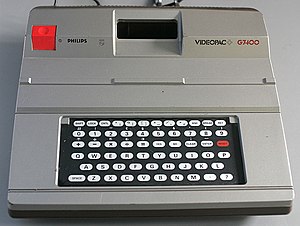Philips Videopac+ G7400
 Philips Videopac+ G7400 console | |
| Manufacturer | Philips |
|---|---|
| Type | Video game console |
| Generation | Third generation |
| Release date | 1983 (1983) |
| CPU | Intel 8048 @ 5.91MHz |
| Memory | 6 KB RAM, 1 KB ROM |
| Display | 320×238 resolution |
| Predecessor | Philips Videopac G7000 |
| Successor | Philips CD-i Philips MSX |
The Philips Videopac+ G7400 is a video game console released in limited quantities in 1983,[1] and only in Europe; an American release as the Odyssey³ Command Center was planned but never occurred. The G7400 was the successor to the Philips Videopac G7000, the European counterpart to the American Magnavox Odyssey².[2] The system featured excellently tailored background and foreground graphics.[3]
The G7400 could play three types of games: all normal G7000 games, special G7000 games with additional high-res background graphics that would appear only when played on the G7400, and G7400-only games with high-res sprites and backgrounds.
Contents
1 Odyssey³
2 Specifications
3 Emulation
4 References
5 See also
6 External links
Odyssey³
There were plans to release the G7400 in the United States as the Odyssey³ and later as the Odyssey³ Command Center; the system was demonstrated at the 1983 Consumer Electronics Show,[4] and some prototypes have been found. The Odyssey³ was never released, mostly because company executives concluded that it was not technologically advanced enough to compete in the marketplace. Also, the video game crash of 1983 ended all lingering hopes for a release.
The Odyssey³ was to feature a real mechanical keyboard, unlike the membrane keyboard found in the G7000 and Odyssey², as well as a built-in joystick holder for dual-joystick games. Prototypes for a 300 baud modem and a speech synthesizer are known to have been made, and a laserdisc interface was planned to allow even more advanced games.
Specifications
CPU: Intel 8048, 5.91 MHz
- RAM: 6 KB + 192 Byte
- ROM: 1 KB
- Display: 320×238×16
- Audio: 1 channel, 8 sounds
- Input / Output: RF modulator, Péritel/SCART connector (with RGB), joystick port(s), ROM cartridge port
- Expansion
- The Voice – Speech synthesis unit, compatible with G7000
- Chess Module – Increased the G7400's computing power such that it could play chess, also compatible with G7000
Microsoft BASIC Home Computer Module (C7420) – Similar to above, with the purpose of converting the G7400 into a "real" computer, not compatible with G7000. An additional Z80 CPU with 16 KB RAM and 16 KB ROM.
- The Voice – Speech synthesis unit, compatible with G7000
Emulation
The emulator O2EM allows G7400 games to be played on modern computers.
References
^ Wolf, Mark J.P.; Perron, Bernard (8 October 2013). The Video Game Theory Reader. Routledge. pp. 312–. ISBN 978-1-135-20519-5..mw-parser-output cite.citation{font-style:inherit}.mw-parser-output .citation q{quotes:"""""""'""'"}.mw-parser-output .citation .cs1-lock-free a{background:url("//upload.wikimedia.org/wikipedia/commons/thumb/6/65/Lock-green.svg/9px-Lock-green.svg.png")no-repeat;background-position:right .1em center}.mw-parser-output .citation .cs1-lock-limited a,.mw-parser-output .citation .cs1-lock-registration a{background:url("//upload.wikimedia.org/wikipedia/commons/thumb/d/d6/Lock-gray-alt-2.svg/9px-Lock-gray-alt-2.svg.png")no-repeat;background-position:right .1em center}.mw-parser-output .citation .cs1-lock-subscription a{background:url("//upload.wikimedia.org/wikipedia/commons/thumb/a/aa/Lock-red-alt-2.svg/9px-Lock-red-alt-2.svg.png")no-repeat;background-position:right .1em center}.mw-parser-output .cs1-subscription,.mw-parser-output .cs1-registration{color:#555}.mw-parser-output .cs1-subscription span,.mw-parser-output .cs1-registration span{border-bottom:1px dotted;cursor:help}.mw-parser-output .cs1-ws-icon a{background:url("//upload.wikimedia.org/wikipedia/commons/thumb/4/4c/Wikisource-logo.svg/12px-Wikisource-logo.svg.png")no-repeat;background-position:right .1em center}.mw-parser-output code.cs1-code{color:inherit;background:inherit;border:inherit;padding:inherit}.mw-parser-output .cs1-hidden-error{display:none;font-size:100%}.mw-parser-output .cs1-visible-error{font-size:100%}.mw-parser-output .cs1-maint{display:none;color:#33aa33;margin-left:0.3em}.mw-parser-output .cs1-subscription,.mw-parser-output .cs1-registration,.mw-parser-output .cs1-format{font-size:95%}.mw-parser-output .cs1-kern-left,.mw-parser-output .cs1-kern-wl-left{padding-left:0.2em}.mw-parser-output .cs1-kern-right,.mw-parser-output .cs1-kern-wl-right{padding-right:0.2em}
^ L'Europeo (in Italian). 39. Editoriale Domus. November 1983. pp. 282–.Il tutto, tradotto dal computerese, significa che invece di programmi si tratterà di una nuova consolle per far girare i programmi stessi, più precisamente il Philips G7400 Il vecchio Philips Videopac aveva il difetto di essere il videogioco con la ...
^ Bali, S.P. (1 March 1994). Colour Television: Theory and Practice. Tata McGraw-Hill Education. pp. 373–. ISBN 978-0-07-460024-5.
^ 1983 CES Odyssey Command Center Promo. Philips. January 14, 2012 [1983] – via the Internet Archive.
See also
- List of Videopac games
- Magnavox Odyssey
External links
| Wikimedia Commons has media related to Magnavox Odyssey². |
Technical data
videopac.nl/forum – Forum dedicated to the Philips Videopac and Magnavox Odyssey2*
Philips G7400 Manual - detailed
